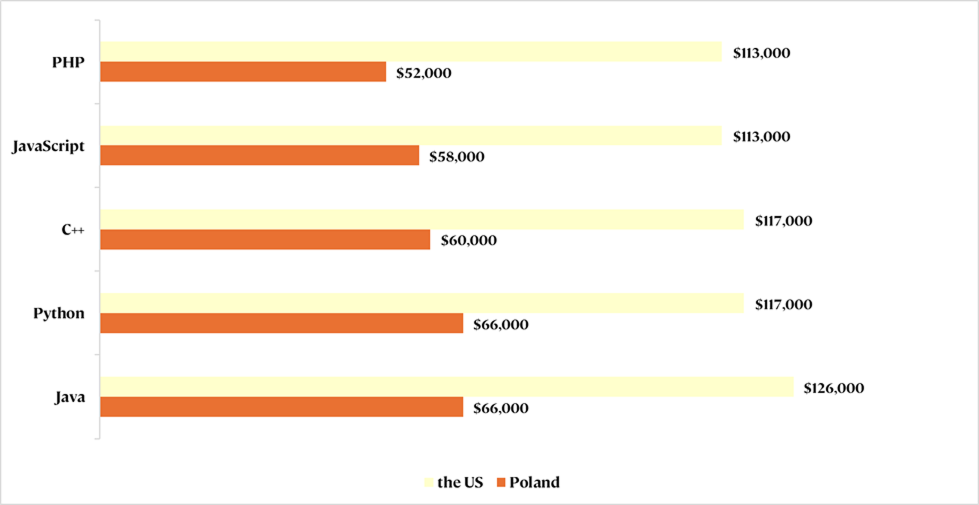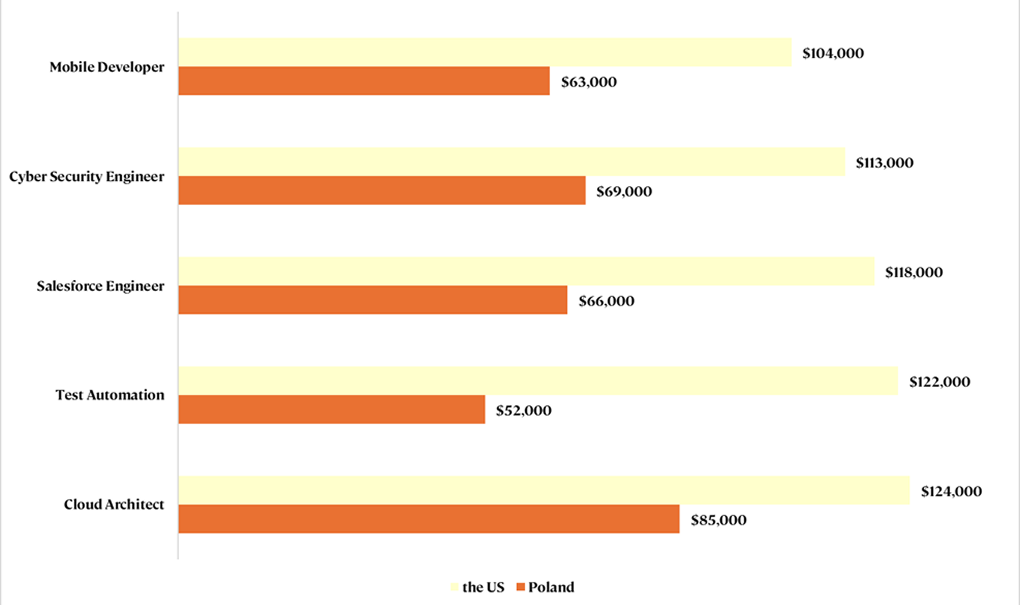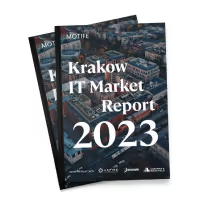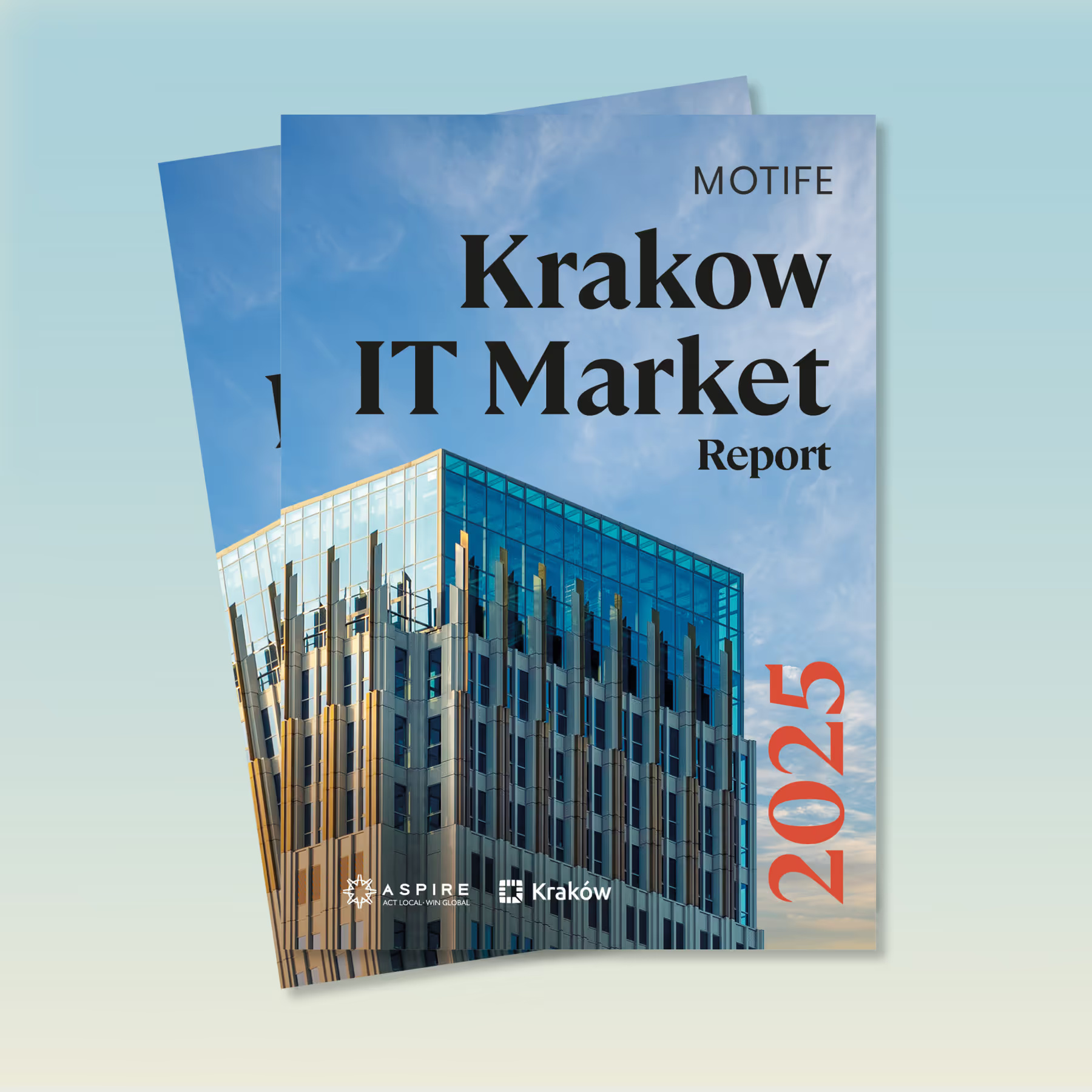While salary arbitrage is a clear advantage, other factors, including education levels, international experience, and favorable legal models, make Poland an attractive destination for long-term team development. In this article, we compare IT salary levels and growth trends in Poland and the United States, highlight key differences in employment structures, and examine the growing footprint of US tech firms in Krakow. We also look at the skills and experience that define the Polish IT workforce, and how these translate into real value for global organizations building remote or hybrid teams.
In 2025, median annual salaries for IT specialists in the United States remain significantly higher than in Poland. For most roles, US professionals earn between 2 and 2.5 times more than their counterparts in Poland, even when comparing the total cost of employment in Poland to gross US-based salaries.
According to available data, a Java developer in Poland typically earns around $70,000 gross annually, while a similar role in the US commands a median gross salary of $126,000. Python, .NET, and C++ developers in Poland earn between $63,000 and $70,500, whereas their US peers earn between $117,000 and $128,000. The largest gap appears in C#/.NET roles, where US compensation exceeds Polish net earnings by more than two times.
The overall cost difference remains significant even after adjusting for cost of living and benefits. This wage disparity, next to the talent quality and availability, is one of the key financial drivers behind American companies’ decisions to build engineering teams in Poland.
Comparison of salaries in key technologies in the US and Poland
in 2025 (median gross salary, yearly for a mid-level specialist with 3-5 years of experience)

Comparison of salaries in key IT professions in the US and Poland
in 2025 (median gross salary, yearly for a mid-level specialist with 3-5 years of experience)
.png)

Between 2020 and 2024, IT salaries in Poland increased by 38%, compared to a 15% rise in the United States. This faster growth reflects strong demand for tech talent in Poland, driven by foreign investment and the expansion of remote work models. However, despite this pace, absolute salary levels in Poland remain significantly lower than in the US.
Notably, salary growth in Poland has slowed over the past three years. In some specializations, particularly in backend development and QA, median rates have stabilized or even slightly declined since 2022. Meanwhile, salaries in the US have continued to rise steadily, maintaining a wide compensation gap between the two markets.
This dynamic means that while Poland is no longer as low-cost as it was five years ago, the country still offers considerable savings and competitive access to talent compared to Western markets.

When comparing employment models in Poland and the United States, companies will encounter several structural differences that impact hiring, taxation, and compliance. In Poland, the standard employment contract (Umowa o pracę) is governed by the Labor Code and includes statutory benefits such as paid vacation, sick leave, and maternity leave.
Alternatively, many IT professionals work under B2B contracts, which are civil law agreements between companies and self-employed individuals. These offer more flexibility but require contractors to manage their own taxes and social security contributions.
In the US, most employment is “at-will,” allowing employers to terminate contracts without cause or notice, and benefits such as paid leave are often discretionary. In Poland, notice periods are regulated and can range from 2 weeks to 3 months, while B2B contracts typically include a 1-month notice clause. In contrast, US terminations are faster but may carry reputational or legal risks depending on the jurisdiction.
Social security contributions are also more burdensome in Poland, with employers covering a significant share of ZUS (public insurance), whereas in the US, contributions are split under the FICA system. Despite these obligations, the overall cost of employment in Poland, factoring in salaries and social security, is still approximately two times lower than in the United States.
It’s important to note that in Poland’s IT industry, B2B contracts and self-employment are not viewed as freelance or entrepreneurial arrangements, as they often are in the United States. Instead, contractors typically work exclusively with one client in a long-term relationship. Engagements usually last for a year and are renewed annually, though some are open-ended. Contractors are paid a daily rate that is generally comparable to salaried employees' compensation. These contracts often include strict non-compete clauses, limiting contractors from doing other work without prior approval.
Check out: B2B contracts in IT industry in Poland
.png)
Krakow serves as a great example of an IT hub in Poland, chosen by American companies to expand their IT operations. American firms have played a leading role in shaping Krakow’s and Poland’s IT ecosystem, with Motorola being the first US company to open its IT hub in Krakow in 1998. They were among the first to set up local operations, and they continue to be some of the largest employers in the region. As of 2024, around 40% of Krakow’s IT talent works for US-based companies, and over 11,000 professionals are employed by the ten largest American firms in the city.
Major names include Cisco, IBM, EPAM Systems, Motorola Solutions, and Aptiv, each operating large-scale R&D and product teams in Krakow. These organizations are not just outsourcing services. Many are building strategic, long-term engineering hubs focused on innovation, delivery, and growth.
Among the US IT hubs operating in the city, 40% specialize in software development, reinforcing Krakow’s position as a major center for software engineering. Another 16% focuses on IT consulting and IT services.
Additionally, US employers from Finance (7%) and Engineering and Manufacturing (6%) reflect a growing diversification of Krakow’s tech ecosystem and signal potential for further expansion in these industries.
US companies hiring IT specialists in Krakow by industry

But for the cost advantage, Polish developers consistently rank among the most skilled in the world. In the global developer skills assessment by HackerRank, Poland placed third. This reflects a strong foundation in algorithms, problem-solving, and computer science fundamentals.
Education levels in the Polish IT sector are high. Around 75% of IT professionals hold degrees in computer science or related fields such as engineering, mathematics, or physics. Krakow’s developer community is particularly experienced, with nearly half of all specialists reporting more than 10 years of professional experience. Many have worked in international companies for over two decades, often delivering software for US- and EU-based clients.
English proficiency supports seamless global collaboration. In the 2024 EF English Proficiency Index, Poland ranked 15th out of 116 countries, placing it in the "very high proficiency" category. Most Polish IT professionals are fluent in English and capable of working directly with distributed teams.
Learn more about what international companies have achieved with their Krakow tech labs by downloading our Krakow IT Market Report 2025
.png)
If you are interested in setting up your own engineering hub in Poland, contact us at MOTIFE to learn more.
If you are looking for interesting job opportunities in tech companies in Poland, check out open roles at motife.com/jobs.
Explore essential data on Poland's tech landscape.




